List
| Rank | Common name | Scientific name | Family | Image | Average mass (kg) in the wild | Maximum mass (kg) in the wild | Average length (m) in the wild | Maximum length (m) in the wild | Average shoulder height (m) in the wild | Native range |
|---|---|---|---|---|---|---|---|---|---|---|
| 1 | Polar bear | Ursus maritimus | Ursidae |  | 360-700 | 1002 | 2.5 - 3.0 | 3.4 [1] | 1.60 | North America, Eurasia |
| 2 | Brown bear | Ursus arctos | Ursidae | 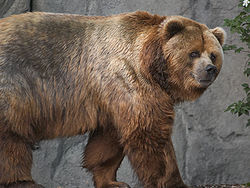 | 270-635 | 751 (in the wild, possibly more) | 1.5 - 3.0 | 3.4 [2] | 1.53 | North America, Eurasia, formerly Africa |
| 3 | American black bear | Ursus americanus | Ursidae |  | 159-226 | 409-500 [3] | 1.4 - 2.0 | 2.41 [3] | 1.10 | North America |
| 4 | Tiger | Panthera tigris | Felidae |  | 227-300 | 388.78 (disputed) [4] [5] [6] | 2.5 - 3.9 | 4.17 [7] | 1.32 | Asia |
| 5 | Lion | Panthera leo | Felidae |  | 190-272 | 375 (in the wild; [8] [9] disputed) [10] | 2.5 - 3.3 | 3.9 [11] | 1.4 | Africa, Asia. |
| 6 | Spectacled bear | Tremarctos ornatus | Ursidae |  | 100-190 | 220 [12] | 1.2 - 1.9 | 2.0 [13] | 1.0 | South America |
| 7 | Asiatic black bear | Ursus thibetanus | Ursidae |  | 90-190 | 200 [14] | 1.3 - 1.9 | 2.0 [15] | 1.10 | Asia |
| 8 | Sloth bear | Melursus ursinus | Ursidae | 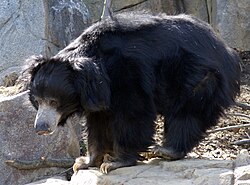 | 90-140 | 192 | 1.2 - 1.9 | 2.0 [16] | 0.90 | Asia |
| 9 | Jaguar | Panthera onca | Felidae | 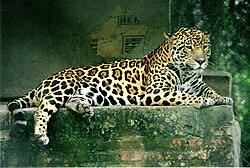 | 100-125 | 160 [17] [18] | 1.6 - 2.5 | 2.8 [19] | 0.90 | North America, South America |
| 10 | Giant panda | Ailuropoda melanoleuca | Ursidae | 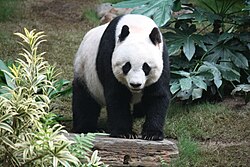 | 85-120 | 160 | 1.5 - 1.9 | 2.0 | 1.0 | Asia |
| 11 | Cougar | Puma concolor | Felidae |  | 53.1–71[ citation needed ] | 105.2 (Verified) [20] 125.2 (Unverified) [21] | 1.5 - 2.4 [22] | 2.8 [23] | 0.53 - 0.88 [24] | North and South America |
| 12 | Leopard | Panthera pardus | Felidae | 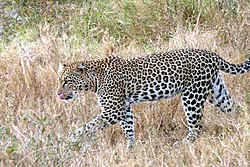 | 30–65.8 [25] [26] | 108 [27] | 1.6 - 2.3 [28] | 2.75 [29] [30] | 0.44 - 0.78 [31] | Africa, Europe and Asia |
| 13 | Gray wolf | Canis lupus | Canidae |  | 14–65 [32] | 79 [33] 86 [34] 103 [35] | 1.4 - 1.90 [36] | 2.13 [37] - 2.5 [38] [39] | 0.97 | North America and Eurasia |
| 14 | Spotted hyena | Crocuta crocuta | Hyaenidae |  | 44.5–63.9 | 81.7-90 | 0.95 - 1.6 | 1.3 | 0.75 [40] | Africa |
| 15 | Brown hyena | Parahyaena brunnea | Hyaenidae |  | 37.7–40.2 | 72.6 | 1.44 [41] | 1.70 | 0.70 - 0.88 | Africa |
| 16 | Cheetah | Acinonyx jubatus | Felidae |  | 36.7–54.1 [42] [43] | 69 [44] | 1.5 - 2.3 [45] | 2.5 [46] [47] [48] | 0.77 - 0.94 [49] | Africa, Asia |
| 17 | Sun bear | Helarctos malayanus | Ursidae |  | 25-65 [50] [51] [52] | 68.3 | 1.0 - 1.40 | 1.50 | 0.70 | Asia |
| 18 | Striped hyena | Hyaena hyaena | Hyaenidae |  | 26-41 | [53] 55 | 0.85 - 1.30 | 1.50 | 0.60 - 0.80 | Africa, Asia |
| 19 | Snow leopard | Panthera uncia | Felidae |  | 42 [54] | 53.8 [55] | 1.6 - 2.1 [56] | 2.5 [57] [58] | 0.60 - 0.66 [59] | Asia |
| 20 | Red wolf | Canis rufus | Canidae |  | 23-39 | 40 [60] | 1.2 - 1.65 [61] | 1.7 [62] | 0.80 | North America |
| 21 | Eurasian lynx | Lynx lynx | Felidae |  | 17.4–21.7[ citation needed ] | 38 [63] | 0.80 - 1.3 [64] | 1.5 [65] [66] | 0.60 - 0.71 [67] | Asia, Europe |
| 22 | Eastern wolf | Canis lycaon | Canidae |  | 23-30 | 36.7 [68] | 0.91-1.65[ citation needed ] | 1.8 [69] | 0.70 | North America |
| 23 | Maned wolf | Chrysocyon brachyurus | Canidae |  | 20-30 | 36 [70] | 1.5 - 1.8 [71] [72] | 1.9 [73] | 0.90 | South America |
| 24 | African wild dog | Lycaon pictus | Canidae |  | 20-30 [74] | 36 [75] | 1.10 - 1.40 [76] | 1.5 [77] | 0.75 | Africa |
| 25 | Coyote | Canis latrans | Canidae |  | 8-20 | 33.91 [78] | 1.0 - 1.3 [79] | 1.5 [80] | 0.70 | North America |
| 26 | Wolverine | Gulo gulo | Mustelidae |  | 7-27,5 | 32 [81] [82] [83] [84] [85] | 0.65 - 1.09 | 1.10 | 0.36 - 0.45 | North America, Eurasia |
| 27 | European badger | Meles meles | Mustelidae |  | 6–7.95 | 27.2 | 1.10 | 0.25 - 0.30 | Eurasia | |
| 28 | Bobcat | Lynx rufus | Felidae |  | 6.4–18.3 | 22.2 (Verified) [86] 27 (Unverified) [87] | 0.475 - 1.25 | 1.30 | 0.30 - 0.60 | North America |
| 29 | Clouded leopard | Neofelis nebulosa | Felidae |  | 16–23 [88] | 26 [88] | 1.2 - 1.6 [89] | 1.9 [90] | 0.46 - 0.56 [91] | Asia |
| 30 | Dhole | Cuon alpinus | Canidae |  | 10-21 | 25 | 0.9 - 1.3 [92] | 1.45 [93] | 0.56 | Asia |